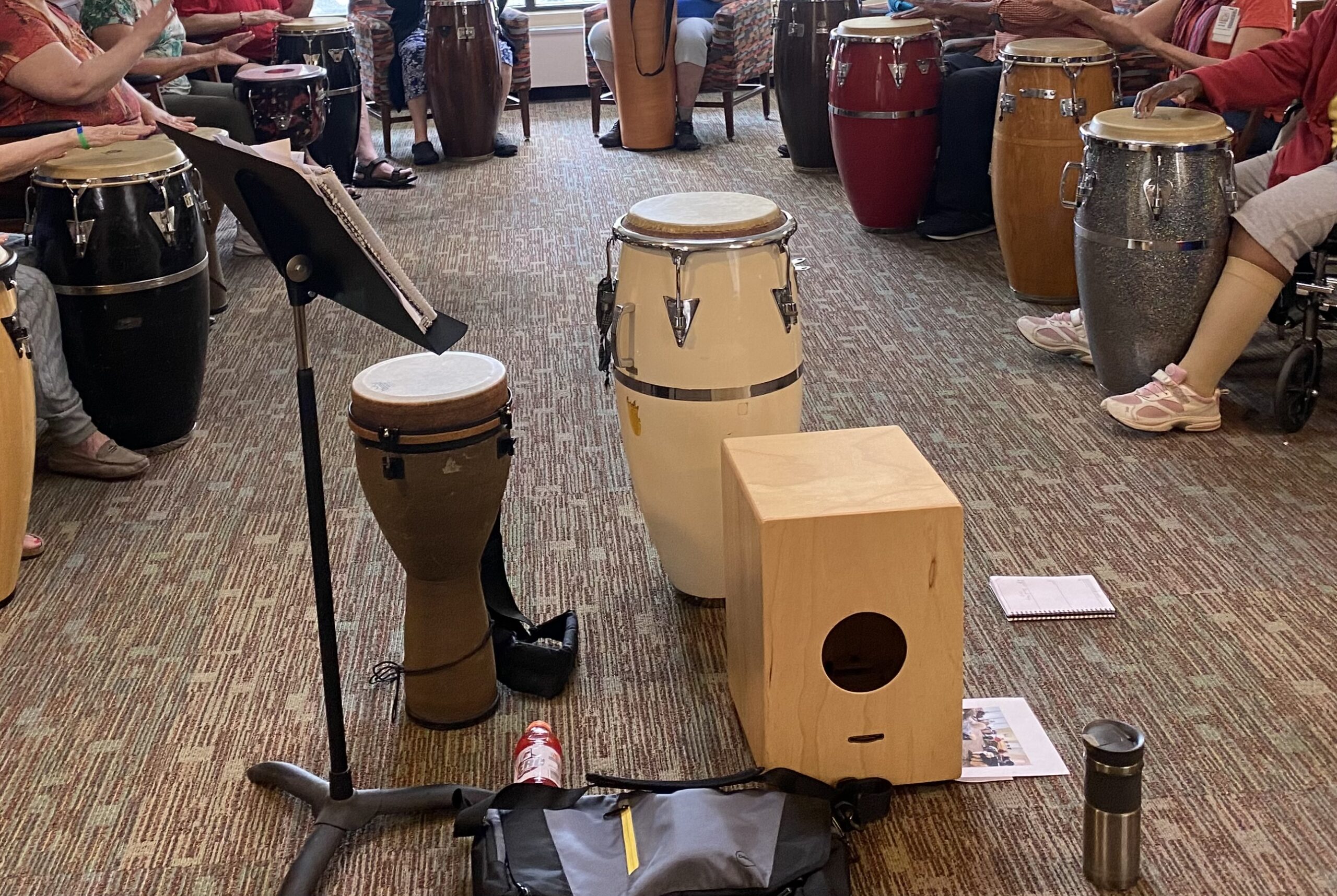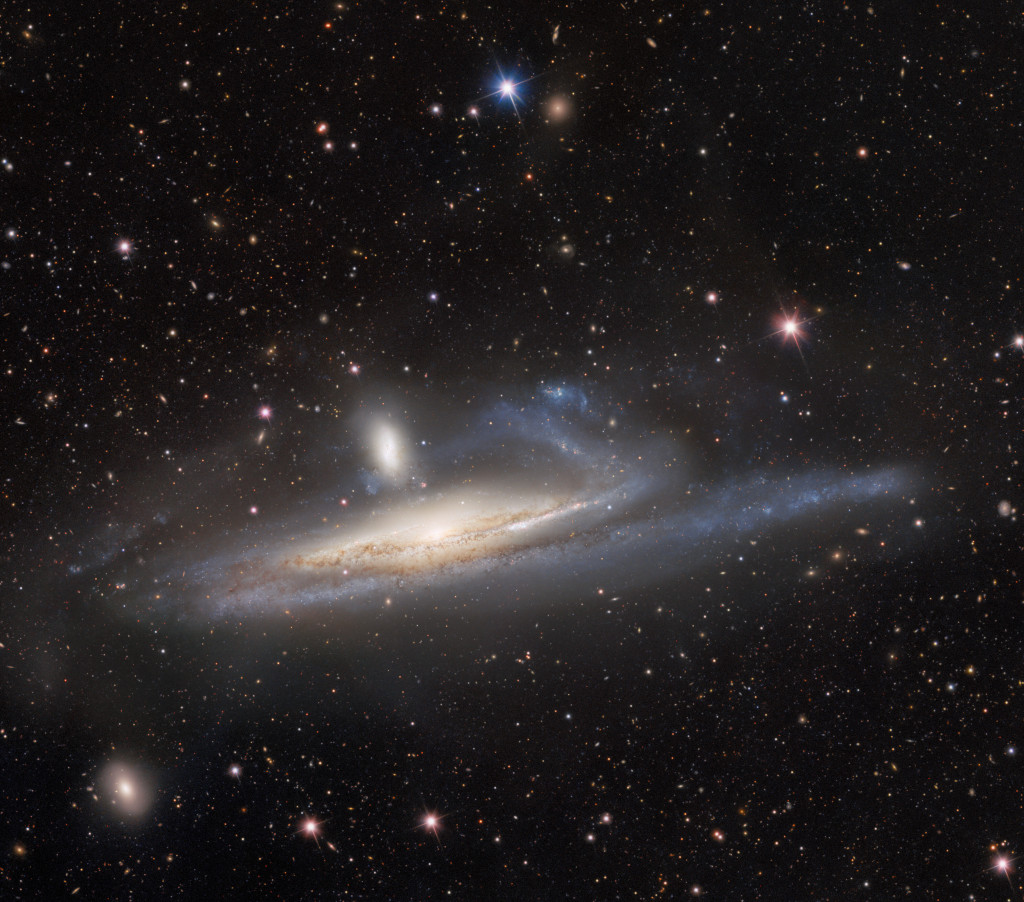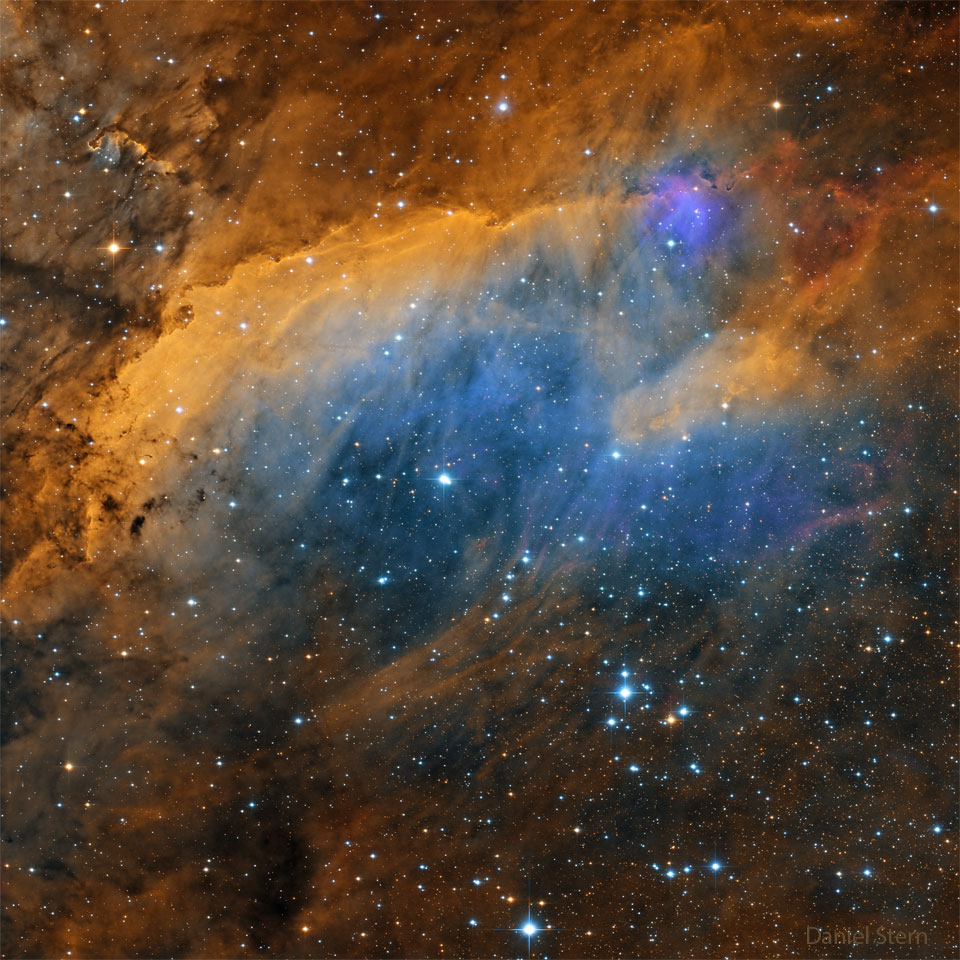Blog

High-speed outflows of molecular gas from a pair of actively forming young stars shine in infrared light, revealing themselves in this NIRcam image from the James Webb Space Telescope. Cataloged as HH (Herbig-Haro) 46/47, the young stars are lodged within a dark nebula that is largely opaque when viewed in visible light. The pair lie at the center of the prominent reddish diffraction spikes in the NIRcam image. Their energetic stellar jets extend for nearly a light-year, burrowing into the dark interstellar material. A tantalizing object to explore with Webb’s infrared capabilities, this young star system is relatively nearby, located only some 1,140 light-years distant in the nauticalconstellation Vela.

Delfeayo Marsalis ( born July 28, 1965) is an American jazz trombonist, record producer and educator.
Marsalis was born in New Orleans, the son of Dolores (née Ferdinand) and Ellis Louis Marsalis, Jr., a pianist and music professor. He is also the grandson of Ellis Marsalis, Sr., and the brother of Wynton Marsalis(trumpeter), Branford Marsalis (saxophonist), and Jason Marsalis (drummer). Delfeayo also has two brothers who are not musicians: Ellis Marsalis III (b. 1964) is a poet, photographer and computer networking specialist based in Baltimore, and Mboya Kenyatta (b. 1970), who has been diagnosed with autism and was the primary inspiration for Delfeayo’s founding of the New Orleans-based Uptown Music Theatre. Formed in 2000, UMT has trained over 300 youth and staged eight original musicals, all of which are based upon the mission of “community unity”.
more...Michael Bernard Bloomfield (July 28, 1943 – February 15, 1981) was an American guitarist and composer, born in Chicago, Illinois, who became one of the first popular music superstars of the 1960s to earn his reputation almost entirely on his instrumental prowess, as he rarely sang before 1969. Respected for his guitar playing, Bloomfield knew and played with many of Chicago’s blues musicians before achieving his own fame and was instrumental in popularizing blues music in the mid-1960s. In 1965, he played on Bob Dylan’sHighway 61 Revisited, including the single “Like a Rolling Stone“, and performed with Dylan at that year’s Newport Folk Festival.
Bloomfield was ranked No. 22 on Rolling Stone‘s list of “100 Greatest Guitarists of All Time” in 2003 and No. 42 by the same magazine in 2011. He was inducted into the Blues Hall of Fame in 2012 and, as a member of the Paul Butterfield Blues Band, was inducted into the Rock and Roll Hall of Fame in 2015.
Bloomfield was born into a wealthy Jewish Chicago family. Bloomfield’s father, Harold Bloomfield, was born in Chicago in 1914. Harold’s father, Samuel Bloomfield, started Bloomfield Industries in the early 1930s. After Samuel passed away, Harold and his brother, Daniel, inherited the company. Bloomfield’s mother, Dorothy Klein, was born in Chicago in 1918 and married Harold in 1940. She came from an artistic, musical family, working as an actress and a model before marrying Harold. Bloomfield died in San Francisco on February 15, 1981. He was found seated behind the wheel of his car, with all four doors locked. According to police, an empty Valium bottle was found on the car seat, but no suicide note was found. The medical examiner who performed the autopsy ruled the death accidental overdose, due to cocaine and methamphetamine poisoning.
more...David “Junior” Kimbrough (July 28, 1930 – January 17, 1998) was an American blues musician. His best-known works are “Keep Your Hands off Her” and “All Night Long”. In 2023, he was inducted in the Blues Hall of Fame.
Kimbrough was born in Hudsonville, Mississippi, and lived in the north Mississippi hill country near Holly Springs. His father, a barber, played the guitar, and Junior picked his guitar as a child. He was apparently influenced by the guitarists Lightnin’ Hopkins, Mississippi Fred McDowell and Eli Green.
more...The Traditional Structure of the Seguiriya
When following the traditional structure, the seguiriya proceeds as follows:
- It begins with a strong guitar strumming, which introduces the singer.
- The first lyrics are short and emotionally intense, topped off with guitar strumming.
- This is followed by a brave singing verse, which is also finished off with the guitar, giving way to the change of lyrics.
- The seguiriya ends with the guitar, strongly playing to the beat.
Singing and Coplas
It is believed that the seguiriya comes from the plañideras, among other reasons, because of the type of singing, which is very somber and uses death as its main theme. Besides, it can be recognized for its lyrics full of moan, also called quejíos. These features are why the seguiriya are considered a pure cante jondo (profound song or deep song), which came along before the palo seco (the dry style of flamenco that isn´t accompanied by guitar music).
more...Absorbing small galaxies that are too close and are captured by the Milky Way’s gravity. In fact, thepractice is common in the universe and illustrated by this striking pair of interacting galaxies from the banks of the southern constellation Eridanus, The River. Located over 50 million light years away, the large, distorted spiral NGC 1532 is seen locked in a gravitational struggle with dwarf galaxy NGC 1531, a struggle the smaller galaxy will eventually lose. Seen nearly edge-on, spiral NGC 1532 spans about 100,000 light-years. The merging galaxies are captured in this sharp image from the Dark Energy Camera mounted on the National Science Foundation’s Blanco 4-meter Telescope at Cerro Tololo Inter-American Observatory in Chile. The NGC 1532/1531 pair is thought to be similar to the well-studied system of face-on spiral and small companion known as M51.

Barbara Gracey Thompson MBE (27 July 1944 – 9 July 2022) was an English jazz saxophonist, flautist and composer. She studied clarinet, flute, piano and classical composition at the Royal College of Music, but the music of Duke Ellington and John Coltrane made her shift her interests to jazz and saxophone. She was married to drummer Jon Hiseman of Colosseum from 1967 until his death in 2018.
more...Nicholas Wells Reynolds (July 27, 1933 – October 1, 2008) was an American folk musician and recording artist. Reynolds was one of the founding members of The Kingston Trio, whose folk and folk-style material captured international attention during the late Fifties and early Sixties.
Born in San Diego and growing up in Coronado, California, his passions as a boy growing up were tennis, skin-diving and singing with his family. His father, a Navy captain, was an avid guitar player who brought back songs from his travels around the world. He taught Nick the guitar and ukulele, and the family spent many nights singing and harmonizing for pure enjoyment. Nick enrolled in Menlo College in 1954 as a business major and met Bob Shane in an accounting class. They soon started socializing together, and this in turn led to playing music, initially as a way of being popular at parties — Shane’s guitar and Reynolds’ bongosbecame a fixture at local fraternity gatherings. After a few weeks of this, Shane introduced Reynolds to Dave Guard
more...Jean Toussaint (born July 27, 1960) is an American jazz tenor and soprano saxophonist.
Toussaint was born in Aruba, Dutch Antilles, and was raised in Saint Thomas and New York City. He learned to play calypso as a child and attended Berklee College of Music in the late 1970s, studying under Bill Pierce (saxophonist). In 1979 he formed a group with Wallace Roney and from 1982 to 1986 was a member of Art Blakey and the Jazz Messengers alongside Terence Blanchard, Donald Harrison, Mulgrew Miller and Lonnie Plaxico. With Blakey he recorded three studio albums, including New York Scene, which won a Grammy for Best Jazz Instrumental Performance.
In 1987, Toussaint moved to London, England, when he was invited to be artist-in-residence at the Guildhall School of Music by Lionel Grigson, at the time the school’s professor of jazz. In the late 1980s Toussaint had a regular slot at the fabled Dingwalls club in Camden Town on Sunday afternoons. Since then, Toussaint has maintained a profile as a band leader in the UK and Europe, playing with British musicians including, among others, Steve Williamson, Courtney Pine, Julian Joseph, Jason Rebello, Cleveland Watkiss. Toussaint has also performed in groups led by McCoy Tyner, Gil Evans, Kirk Lightsey, Cedar Walton, Max Roach, Horace Silver and Jeff Tain Watts. In addition he has collaborated with Lionel Loueke.
Toussaint has released 10 albums as a leader, his most recent entitled Tate Song in February 2014 with LYTE Records.
In 2015/16 Toussaint devised a project dedicated to his mentor Blakey. The project was entitled “Roots & Herbs: The Blakey Project” and featured an all-star lineup of British jazz musicians, including Julian Joseph, Byron Wallen, Dennis Rollins, Jason Rebello and Shane Forbes. The group toured the UK extensively throughout 2015 / 2016
more...Karibuni the East African ensemble will perform Wednesday July 26 2023 at 1030am. ‘Featuring Shalita (Uganda), Sei Kpolar (Liberia) and mick laBriola Bringing music, cultural diversity, geography and history to St Peter Library in St Peter, MN https://www.saintpetermn.gov/299/Library Gubare Mpambara is pictured but not performing today.

more...
South of Antares, in the tail of the nebula-rich constellation Scorpius, lies emission nebula IC 4628. Nearby hot, massive stars, millions of years young, irradiate the nebula with invisible ultraviolet light, stripping electrons from atoms. The electrons eventually recombine with the atoms to produce the visible nebular glow, dominated by the red emission of hydrogen. At an estimated distance of 6,000 light-years, the region shown is about 250 light-years across, spanning over three full moons on the sky. The nebula is also cataloged as Gum 56 for Australian astronomer Colin Stanley Gum, but seafood-loving deep sky-enthusiasts might know this cosmic cloud as the Prawn Nebula. Thegraceful color image is a new astronomical composition taken over several nights in April from Rio Hurtado, Chile.

more...
Sir Michael Philip Jagger (born 26 July 1943) is an English singer and songwriter. He is the lead vocalist and one of the founders of the rock band the Rolling Stones. He and guitarist Keith Richards have written most of the band’s songs together; their songwriting partnership is among the most successful in history.
Jagger’s career has spanned over six decades, and he has been widely described as one of the most popular and influential frontmen in the history of rock music. His distinctive voice and energetic live performances, along with Richards’ guitar style, have been the Rolling Stones’ trademark throughout the band’s career. Jagger gained notoriety for his romantic involvements and illicit drug use, and has often been portrayed as a countercultural figure.
Born and raised in Dartford, Jagger studied at the London School of Economics before abandoning his studies to join the Rolling Stones. In the late 1960s, Jagger starred in the films Performance (1970) and Ned Kelly (1970), to mixed receptions. Beginning in the 1980s, he released a number of solo works, including four albums and the single “Dancing in the Street“, a 1985 duet with David Bowie that reached No. 1 in the UK and Australia and was a top-ten hit in other countries.
In the 2000s, he co-founded a film production company, Jagged Films, and produced feature films through the company beginning with the 2001 historical drama Enigma. In 2009, he joined the electric supergroupSuperHeavy.
Relationships with his bandmates in the Rolling Stones—particularly Richards—deteriorated during the 1980s, but Jagger has always found more success with the band than with his solo and side projects. He was married to Bianca Pérez-Mora Macias from 1971 to 1978, and has had several other relationships; he has eight children with five women.
In 1989, Jagger was inducted into the Rock and Roll Hall of Fame and, in 2004, into the UK Music Hall of Fame with the Rolling Stones. As a member of the Rolling Stones and as a solo artist, he reached No. 1 on the UK and US singles charts with 13 singles, the top 10 with 32 singles and the top 40 with 70 singles. In 2003, he was knighted for his services to popular music. The genus Jaggermeryx naida and the type speciesAegrotocatellus jaggeri are named for him. Jagger is credited with bringing a style and sexiness to rock and roll and with being a trailblazer in pop music that have been imitated and proven influential with subsequent generations of musicians.
more...Erskine Ramsay Hawkins (July 26, 1914 – November 11, 1993) was an American trumpeter and big bandleader from Birmingham, Alabama, dubbed “The 20th Century Gabriel”. He is best remembered for composing the jazz standard “Tuxedo Junction” (1939) with saxophonist and arranger Bill Johnson. The song became a hit during World War II, rising to No. 7 nationally (version by the Erskine Hawkins Orchestra) and to No. 1 nationally (version by the Glenn Miller Orchestra). Vocalists who were featured with Erskine’s orchestra include Ida James, Delores Brown, and Della Reese. Hawkins was named after Alabama industrialist Erskine Ramsay.
Erskine Hawkins was named by his parents after Alabama industrialist Erskine Ramsay who was rewarding parents with savings accounts for them for doing so. Hawkins attended Councill Elementary School and Industrial High School (now known as Parker High School) in Birmingham, Alabama. At Industrial High School, he played in the band directed by Fess Whatley, a teacher who taught many African-American musicians, many of whom worked with such musicians as Duke Ellington, Lucky Millinder, Louis Armstrongand Skitch Henderson (of the NBC Orchestra).
more...Joanne Brackeen (born Joanne Grogan; July 26, 1938) is an American jazz pianist and music educator.
Brackeen was born in Ventura, California, United States, and attended the Los Angeles Conservatory of Music.[1] She was a fan of pop pianist Frankie Carle before she became enamored with the music of Charlie Parker. In the 1950s she performed with Dexter Gordon, Teddy Edwards, and Charles Brackeen. She and Brackeen married and moved to New York City in 1965. She performed with Chick Corea, Freddie McCoy, and Ornette Coleman.
She played with Joe Henderson (1972–75) and Stan Getz (1975–77) before leading her own trio and quartet. She established herself as a cutting-edge pianist and composer through her appearances around the world, and her solo performances also established her reputation as an innovative and dynamic pianist. Her trios featured such noted players as Clint Houston, Eddie Gómez, John Patitucci, Jack DeJohnette, Cecil McBee and Billy Hart.
She served on the grant panel for the National Endowment for the Arts, toured the Middle East with the US State Department as sponsor, and had solo performances at Carnegie Hall.
She has recorded over 20 albums as a lead musician. She is currently a professor at the Berklee College of Music and at The New School.
more...More Posts
- Cosmo NGC 5530
- Lee Oskar
- Paul McCandless
- Boogie Bill Webb
- Carol Kaye
- Georg Philipp Telemann
- Steve Kuhn
- World Music Elana Sasson · Matthieu Saglio
- Daily Roots Cornell Campbell
- Cosmo Vela SNR
- Chaka Khan
- David Grisman
- Robert Cage
- Louisiana Red
- Stick McGhee
- World Music Ablaye Badji
- Daily Roots Marcia Griffiths
- Trans Measles
- Coco Tea Memorial
- Department of Education